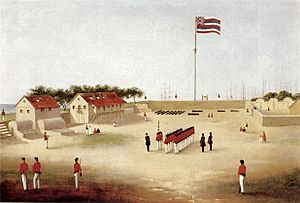French invasion of Honolulu facts for kids
Quick facts for kids French Invasion |
|||||||
|---|---|---|---|---|---|---|---|
 Honolulu Fort, 1853 |
|||||||
|
|||||||
| Belligerents | |||||||
| Commanders and leaders | |||||||
| Strength | |||||||
| 1 frigate 1 corvette 140 Marines |
1 fortress | ||||||
The French invasion of Honolulu was an attack on Honolulu, the capital city of the Hawaiian Kingdom. It happened in 1849. French Admiral Louis Tromelin led the attack. He was upset about how Catholics were treated and how French trade was limited in Hawaii. This event is also known as the Sacking of Honolulu or the Tromelin Affair.
Contents
Why the French Invaded Honolulu
In 1843, France and Hawaii signed a treaty. In this treaty, France promised not to take over any part of Hawaii. However, in 1848, the French government sent a new representative, Guillaume Patrice Dillon, to Honolulu. Dillon was told to be firm but also calm.
But Dillon had other ideas. On November 5, 1848, he wrote to France. He believed that just showing a French warship in Honolulu for three days would make the Hawaiian government give in to their demands.
French Ships Arrive
On August 12, 1849, French Admiral Louis Tromelin arrived in Honolulu Harbor. He came with two warships: the Gassendi, which was a smaller warship called a corvette, and the La Poursuivante, a larger warship called a frigate.
While in Honolulu, Tromelin learned about problems from Dillon. He heard about how Catholics had been treated badly. He also found out about high taxes on French brandy. Tromelin was angry. He believed that American Protestant missionaries were trying to stop Catholicism and French trade. So, Tromelin and Dillon wrote ten demands for King Kamehameha III. These demands were given to the King on August 22.
Tromelin's Demands to Hawaii
Admiral Tromelin made ten specific demands to the Hawaiian government. These demands covered trade, religion, and how French citizens were treated. Here are some of the main points:
- The Hawaiian government needed to fully follow a treaty signed in 1846.
- Taxes on French brandy should be cut in half.
- Catholic schools should be overseen by the French Catholic mission. They also wanted Catholic and Protestant schools to be treated equally.
- The French language should be used when French citizens dealt with the Hawaiian government.
- Rules that made French whaling ships pay extra taxes on wine and spirits should be removed. Also, rules that made ships carrying alcohol pay customs officers on board should be stopped.
- All money collected from the unfair taxes mentioned above should be returned.
- A fine paid by a whaling ship called General Teste should be returned. The ship should also get money for the time it was held in port.
- Some school boys who behaved badly in church should be punished.
- The governor of Hawaii should be removed. This was because police officers had entered a priest's home without permission. Or, the governor should make things right with the priest.
- A French hotel owner should be paid for damages caused by sailors from a British ship.
The Attack on Honolulu Fort
The Hawaiian government did not meet the French demands by August 25. That afternoon, the French gave a second warning to the people of Honolulu. They said an invasion was coming.
Soon after, 140 French Marines landed by boat. They brought two small cannons and ladders for climbing walls. The marines easily took the Honolulu Fort. The fort was almost empty. The two men defending it, Governor of Oahu Mataio Kekuanaoa and Marshal of the Kingdom Warren Goodale, did not fight back. The fort had been emptied before the French arrived.
What the French Did
Inside the fort, the marines disabled the coastal guns. They threw barrels of gunpowder into the harbor. They also destroyed other weapons they found, like muskets and ammunition.
The French Marines then raided government buildings and other property in Honolulu. They caused about $100,000 worth of damage. They also took the king's yacht, named Kamehameha III. This yacht was sailed to Tahiti and was never returned to Hawaii.
After these raids, the French invasion force went back to the fort. During the time the French occupied the fort, people in Honolulu made fun of them. On August 30, some locals even pretended to attack. This made the French Marines double their guard and send out patrols late into the night. But they didn't find any real attackers. Admiral Tromelin eventually called his men back. The French left Hawaii on September 5.
After the Invasion
Gerrit P. Judd led a group to investigate and try to solve the problem. They left for Paris, France, on September 11. On their way, Judd asked for help from the United States and the United Kingdom. The United Kingdom agreed to support his case against Tromelin.
At first, the French government did not approve of the attack on Honolulu. But then, they heard the side of the story from Tromelin and Dillon. Both of them had left Hawaii with Tromelin on September 5. After hearing their accounts, the French government decided the attack was more justified. Because of this, they did not pay for the damages caused in Honolulu.

